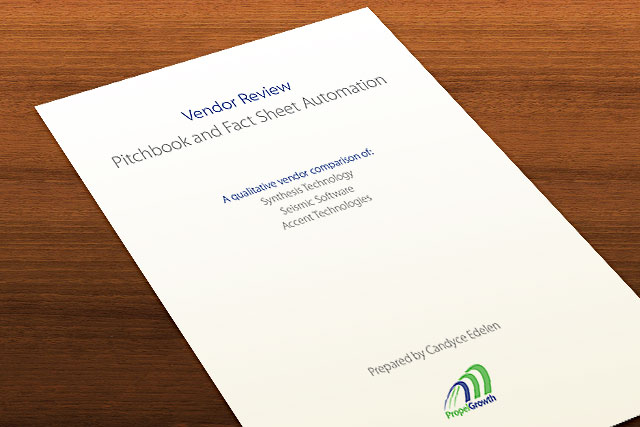![]()

Competitive analysis is a key component of your marketing, sales and product strategy. If you don’t know where your company fits into the competitive landscape, you won’t know how to position your offering, what alternatives your prospects might consider, or what improvements are most critical in order to compete.
But effective analysis is really hard to do. If you do it internally, you have to rely on information you can collect from third parties and your competitors’ websites. You can hire an analyst firm, but that’s very expensive, and they don’t always focus on the key factors that really drive buying decisions.
Recently, one of our clients, Synthesis Technology, asked us to conduct a competitive analysis of their product compared to two of their competitors. We analyzed pitch book and fact sheet automation providers that focus on the wealth/fund management industry. Competition is intensifying in this automation space, with new entrants bringing innovative products to compete with entrenched vendors. At the same time, more fund companies are recognizing a need for this type of automation, creating new market opportunity for the providers.
A Challenging Project
This was an interesting project. While we were engaged by a specific vendor, we needed to stay as neutral as possible in the analysis – to protect our integrity, to give the client meaningful results by which they could evaluate their strategy, and to provide the target audience with a meaningful and useful tool to help in their buying process. But at the same time, we faced limitations in terms of budget, timeframe, and my own technical expertise with these types of products.
Our Methodology
We engaged a former product marketing executive from a large fund manager to help with this analysis, as she is a user and represents our target audience. We started out reviewing interview notes and transcripts from buyer persona interviews and win/loss analyses we’d conducted with the client over the past several months. From these, we compiled a list of value drivers that drove buyer decisions – both for and against our client.
We focused on the value drivers instead of features to allow us to create a more qualitative analysis. This was partly driven by expediency, partly by what the buyers would need to make decisions.
Once we had the value drivers, we reviewed the vendor websites and any other information we could obtain on the Internet. Then we interviewed the vendors’ sales people and product managers, viewed demos and dug into functionality. Then we prepared a written review based on the issues that we believed were most important to the buyers based on our reasearch. The analysis was limited in scope for budget reasons, but it did provide insights that the client has found very helpful as they plan their strategy.
Difficulty of Quantitative Analysis
Originally, I had planned to evaluate the vendors using a strategy canvas template we developed, based on a competitive analysis tool we purchased from Demand Metric.
That tool didn’t really work for three reasons:
- The tool asks for numerical ranking for each vendor and each value driver. It lays them out in a matrix, creating a sort of heatmap showing where the various firms fit. But the value drivers we identified are more qualitative than quantitative, making it tricky to assign a number that I’d feel comfortable standing behind.
- We needed more information about pricing and market sizing that we had access to, and we didn’t have budget to define these in the scope of this project.
- The charts in our template are designed to consider 5-7 different firms. They don’t really provide much meaningful information if we only include 3 firms.
So we ended up eliminating the charts from the final work product.
Target Audience
Our target audience was marketing and product managers at investment management firms, asset and wealth managers, retirement plan providers, TAMPS, and hedge funds. Our goal was to give these people a valuable tool that would support their search for automation solutions.
Results
The client has found the competitive analysis very helpful. It gave them more insight into where they fit in the market and is helping them to better evaluate leads based on likely fit. This is enabling them to focus limited sales resources on prospects that are more likely to close, and stop competing for opportunities that are better fits for their competitors. It provides a key offer that they can provide in the evaluation stage to help prospects prioritize key buying criteria. In addition, they are using the insights to formulate their product strategy and product roadmap.
Check Out the Competitive Analysis Work Product
Our client has given us permission to share this review with you. Click here if you’d like to see what we produced.
- 4 Steps to Optimize Your LinkedIn Profile for Sales Prospecting – February 12, 2021
- The Reality of Cold Calling for B2B Sales – January 11, 2021
- Can Inbound Marketing Generate Enough Leads? – January 9, 2021






